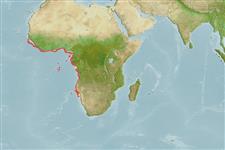Actinopterygii (ray-finned fishes) >
Ophidiiformes (Cusk eels) >
Ophidiidae (Cusk-eels) > Neobythitinae
Etymology: Lamprogrammus: Greek, lampros = light + Greek, gramma = letter, signal (Ref. 45335). More on author: Poll.
Environment / Climate / Range
Ecology
Marine; bathydemersal; depth range 260 - 700 m (Ref. 34024), usually 550 - 700 m (Ref. 27121). Deep-water, preferred ?; 12°N - 23°S
Eastern Atlantic: Guinea Bissau to Namibia.
Size / Weight / Age
Maturity: Lm ? range ? - ? cm
Max length : 46.2 cm SL male/unsexed; (Ref. 3686)
Short description
Morphology | Morphometrics
Uncommon species (Ref. 34024). Feed on pelagic crustaceans like euphausiids, mysids and decapods (Ref. 27637). Found on or above continental slope (Ref. 36731). Oviparous, with oval pelagic eggs floating in a gelatinous mass (Ref. 205).
Life cycle and mating behavior
Maturity | Reproduction | Spawning | Eggs | Fecundity | Larvae
Nielsen, J.G., D.M. Cohen, D.F. Markle and C.R. Robins, 1999. Ophidiiform fishes of the world (Order Ophidiiformes). An annotated and illustrated catalogue of pearlfishes, cusk-eels, brotulas and other ophidiiform fishes known to date. FAO Fish. Synop. 125(18):178p. Rome: FAO. (Ref. 34024)
IUCN Red List Status (Ref. 115185)
CITES (Ref. 94142)
Not Evaluated
Threat to humans
Harmless
Human uses
More information
Age/SizeGrowthLength-weightLength-lengthLength-frequenciesMorphometricsMorphologyLarvaeLarval dynamicsRecruitmentAbundance
ReferencesAquacultureAquaculture profileStrainsGeneticsAllele frequenciesHeritabilityDiseasesProcessingMass conversion
Tools
Special reports
Download XML
Internet sources
